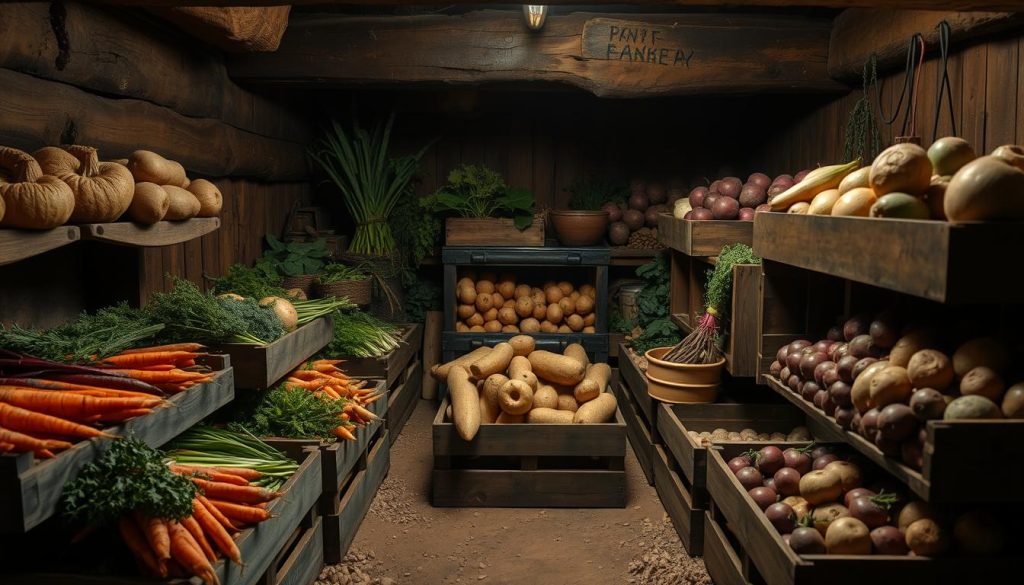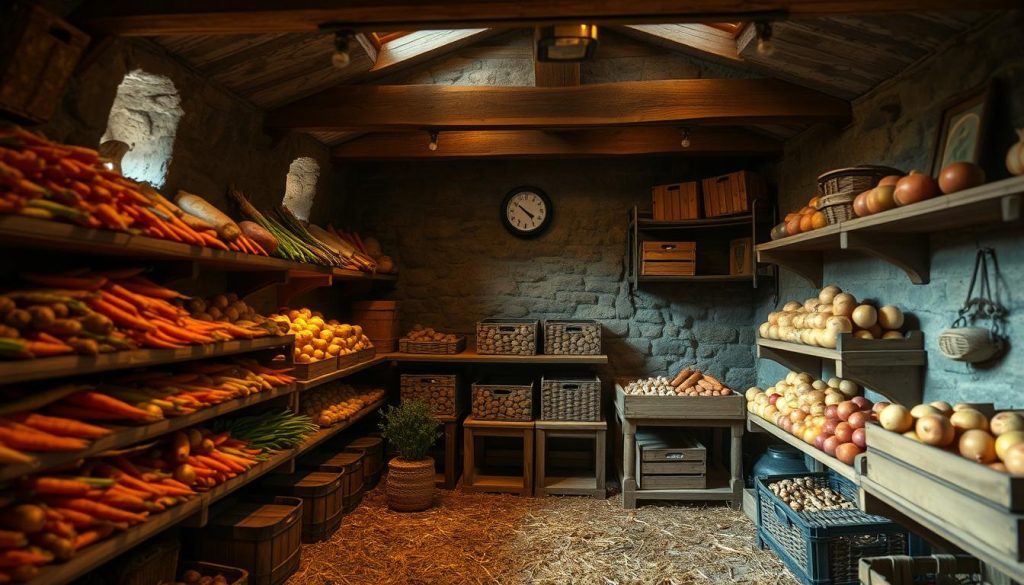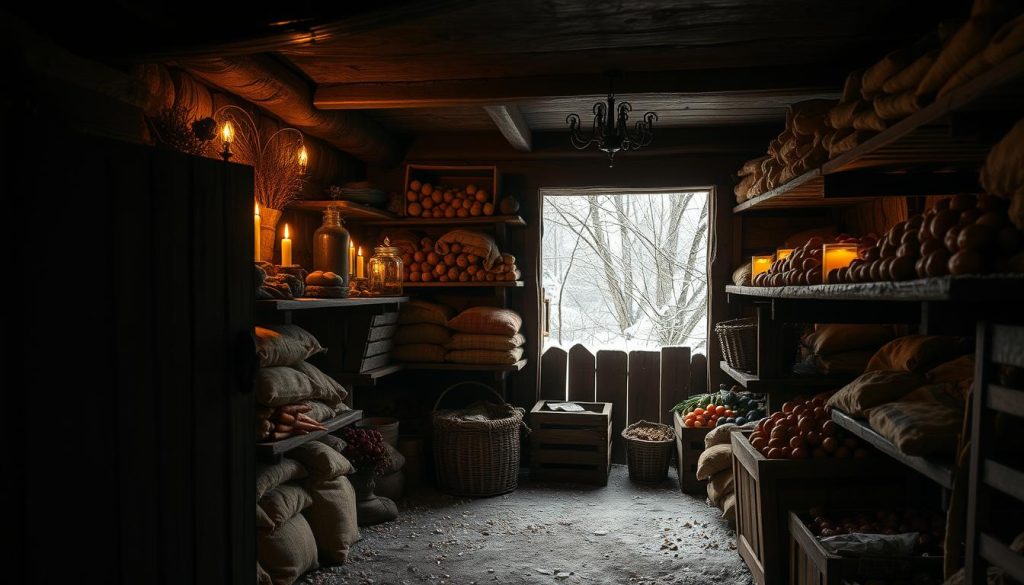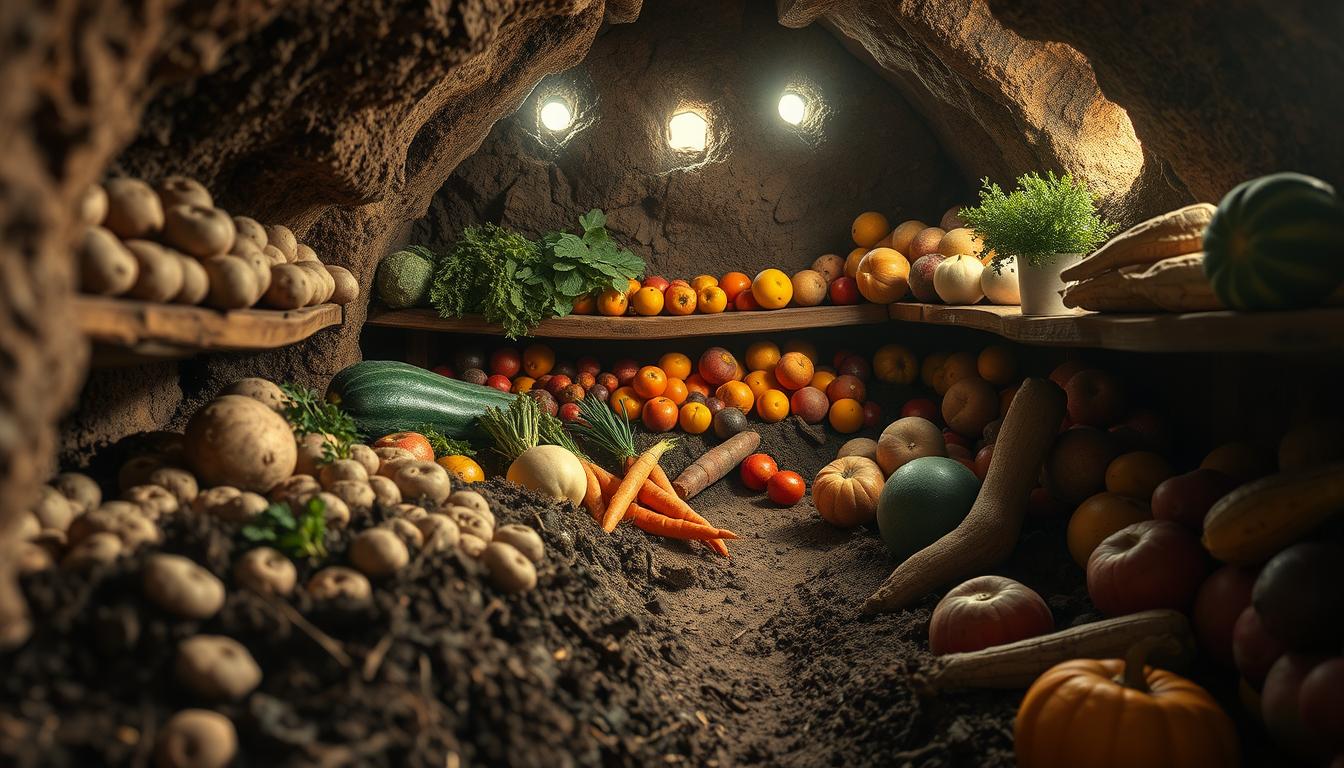Root cellars are becoming more popular as we move towards sustainable living. They are great for keeping vegetables fresh longer and reducing waste. With the right tips, you can keep your vegetables fresh even in modern homes.
Today’s root cellars are inspired by old designs but fit modern homes. They help us enjoy fresh produce all year. This practice is good for the planet and saves money, making it easy for everyone to live greener.
Understanding the Benefits of a Root Cellar
Using a root cellar is a smart move for keeping food fresh longer. It’s a traditional method that saves money and keeps food healthy.
Extended Freshness for Seasonal Produce
Root cellars help keep your food fresh for weeks or even months. The National Center for Home Food Preservation says items like apples, carrots, and potatoes stay fresh longer in a root cellar.
Preservation of Nutritional Value
Storing food in a root cellar also keeps nutrients in. The USDA says cool temperatures help keep nutrients in fruits and veggies. So, you can enjoy your food longer without losing its health benefits.
Cost Savings on Groceries
Another great thing about root cellars is saving money on food. Buying produce in bulk and storing it right can cut down your grocery costs. This makes root cellar storage a good choice for saving money.
Ideal Conditions for Root Cellar Storage
To get the best results from your root cellar, you need to know about optimal storage conditions. This means keeping the right balance of temperature, humidity, and light.
Temperature Considerations
The right temperature and humidity are key to keeping your veggies fresh. Experts say the best temperature for most root veggies is between 32°F and 40°F. This slows down the veggies’ growth, making them last longer.
Humidity Levels and Air Circulation
Keeping the right humidity is also important. Experts suggest keeping the humidity at 85% to 95% for most veggies. Good air flow helps keep this humidity level, preventing dryness and rot. It’s a good idea to check the humidity often and adjust it if needed.
Light Control Strategies
Light control is also crucial for keeping veggies fresh. Light can cause veggies to sprout and spoil. To prevent this, store them in dark places or use blackout curtains. This keeps your root cellar the perfect place for long-term storage.
Selecting the Right Location for Your Root Cellar
Finding the perfect spot for your root cellar is key to keeping food fresh. We’ll look at what to consider and mistakes to steer clear of when planning your root cellar.
Factors to Consider in Location
Start by understanding your area and property. Your root cellar should be cool, dark, and dry. Look for a spot with good drainage to avoid water problems.
It’s also smart to pick a location close to your house for easy access. But remember, it should be far from heat sources like foundation walls and pipes.
Avoiding Common Mistakes
Many people make mistakes when building their root cellar. One big error is forgetting about ventilation. Without it, mold and mildew can grow.
Another mistake is not leaving enough space for air to move. This is important for keeping the temperature steady. Also, don’t build your root cellar near big trees. Their roots can damage the cellar walls.
Assessing Space Requirements
Getting the right size for your root cellar is crucial. It should fit all your storage needs and allow for airflow. Measure your items carefully to ensure there’s enough room.
Plan ahead to avoid problems later. This will make your root cellar a valuable asset for years to come.
Best Types of Vegetables for Root Cellar Storage

Storing root vegetables in a root cellar can make them last longer and stay fresh. The secret is to pick the right vegetables for these conditions. Let’s explore the top picks for your root cellar.
Hard Vegetables: Carrots and Beets
Carrots and beets are great for root cellar storage. They can last months if stored right. Carrots need slightly damp sand to stay moist. Beets prefer cool, dark spots, best at 32-40°F.
Alliums: Onions and Garlic
For alliums like onions and garlic, there are special storage tips. Experts say to cure them first by drying the bulbs until they’re papery. Store them in a cool, dry spot in mesh bags or baskets. This helps prevent mold and sprouting.
Other Root Vegetables: Potatoes and Turnips
Farming guides say potatoes and turnips are also good for root cellars. Potatoes need dark, humid spots (80-90%) to avoid drying out. Turnips should be stored like carrots, in moist sand or sawdust. Choosing the right vegetables keeps them fresh longer.
Preparing Produce for Storage
Getting your produce ready for storage is key to keeping it fresh longer. We’ll look at how to clean, cure, and pack your veggies for the best storage in a root cellar.
Cleaning Techniques Before Storing
Before you store, cleaning is crucial to get rid of dirt and harmful stuff. Use a soft brush or cloth to wipe off dirt from root veggies. Don’t use water as it can cause bacteria to grow. For leafy greens, trim off stems and throw away bad leaves.
The Importance of Curing
Curing veggies like potatoes and onions is important. It makes the outer layer hard and heals small cuts. This step helps prevent rot and keeps your veggies fresh longer. Keep them in a warm, dry, and well-ventilated spot for about two weeks before moving to the root cellar.
Best Practices for Packing
Using the right packing methods is key to stop rot and save space. Store different veggies apart to avoid contamination. Use crates or bins with holes for air to flow. Add straw or newspaper between layers to keep humidity right and stop mold.
Tips for Organizing Your Root Cellar

Organizing your root cellar well is key to keeping produce fresh and easy to find. A good system uses space wisely and keeps things in order. This way, you get the most out of this old food storage method.
Creating a Storage System
Starting with a good storage plan is crucial for root cellar organization. First, sort your produce by type and how it’s stored. For instance, put alliums, root veggies, and hard veggies in their own spots. Also, using shelves and bins can really help use space better. It makes it easier to keep things tidy and within reach.
Labeling Produce
Effective produce labeling is a must for good root cellar management. Label each bin or shelf with what’s inside and when it was picked. This way, you always know what you have and when it was harvested. It helps you keep track of your stock and use older items first.
FIFO Method: First In, First Out
I believe in the FIFO storage method for keeping produce quality up and waste down. This means putting new items behind older ones. So, the oldest produce is always ready to be used first. This method not only keeps items fresh longer but also helps you check on their condition.
How to Monitor Root Cellar Conditions
Keeping your root cellar in top shape is key to keeping your food fresh. Here are some tips for maintaining your root cellar.
DIY Temperature and Humidity Tools
Start by using DIY tools like hygrometers and thermometers. These tools help you track the temperature and humidity in your root cellar. Regular checks let you make changes to keep your food fresh.
Regular Inspection Tips
Regular checks are vital for your root cellar’s health. Inspect your cellar and food at least once a week. Look for moisture or temperature changes. Early detection helps avoid big problems.
Signs of Spoilage to Watch For
Spotting spoilage early is crucial. Look for bad smells, mold, or soft spots on your food. Removing spoiled items quickly stops decay from spreading.
Duration of Storage for Common Produce
Knowing how long to store your produce is key to keeping it fresh and nutritious. By managing storage well, you can keep your fruits and veggies in top shape. Let’s look at the storage times for root veggies and fruits, and some tips to make them last longer.
Storage Times for Root Vegetables
Root veggies like potatoes, carrots, and beets have different storage times. The USDA says potatoes can last up to six months in a cool, dark place. Carrots and beets can stay fresh for three to five months.
Expiry Dates for Fruits
Fruits usually don’t last as long as veggies. Apples, for instance, can stay fresh for three to six months if stored right. Knowing when fruits go bad helps you eat them before they spoil.
Extending Longevity with Proper Techniques
To make your produce last longer, follow a few simple steps. Check for any signs of spoilage often. Make sure there’s enough air, and keep the temperature and humidity steady. These tips can really help your produce stay fresh longer.
Troubleshooting Common Root Cellar Issues
Keeping a root cellar can be tricky, but you can solve common problems with the right steps.
Preventing Rot and Mold Growth
Stopping root cellar mold is crucial. Make sure you have good air flow and watch the humidity. Experts say:
- Put a dehumidifier in the cellar to keep moisture in check.
- Clean with vinegar solutions to fight mold naturally.
- Check your food often and toss any moldy items.
Dealing with Pests Naturally
Organic pest control is vital for a healthy root cellar. Here are some tips:
- Use diatomaceous earth around the cellar to keep insects away.
- Bring in spiders to eat pests.
- Set up traps for rodents without chemicals.
Addressing Temperature Fluctuations
Keeping the cellar temperature stable is key for your food’s life span. Here are some ways to control the climate:
- Insulate walls with straw bales or foam boards.
- Check the temperature with a thermometer.
- Use a small heater or fan to adjust extreme temperatures.
Seasonal Considerations for Root Cellar Use

Using your root cellar well means changing how you do things with the seasons. By adjusting your methods with the seasons, you keep your food fresh and good to eat.
Preparing for Winter Storage
For winter root cellar prep, keeping the temperature cool and steady is key. Make sure your insulation is strong and there are no leaks. Store a variety of root veggies like carrots, beets, and potatoes to have fresh food all winter.
Watch out for too much moisture and mold to stop food from going bad. Store food in big enough portions to last. Use bins and shelves to keep different foods separate.
Mid-Season Adjustments
Changing how you store food is important when the seasons shift. These seasonal storage adjustments mean keeping an eye on humidity and making sure air can move. Check all your food to throw away any that’s bad to keep the rest fresh.
- Check and regulate humidity levels
- Ensure continuous air circulation
- Remove and dispose of any spoiled produce
Planning for Early Spring
When winter ends and spring starts, it’s time for spring root cellar planning. Start by cleaning and airing out your cellar for new food. Switch from winter to spring veggies like radishes, peas, and greens, watching the temperature and humidity closely.
Make sure your cellar is ready for new food. Fix any shelves or ventilation you need. Planning for spring helps use your space well and keeps your diet interesting and healthy.
- Clean and air out the root cellar
- Monitor and adjust temperature and humidity levels
- Transition from winter crops to early spring produce
Enhancing Your Root Cellar
Improving your root cellar can make your stored produce last longer. You can use natural insulation, add shelving and bins, and get creative with small spaces. These strategies help you get the most out of your root cellar.
Utilizing Natural Insulation Methods
Consider using straw, hay, or sawdust for insulation. These materials keep the temperature steady, which is key for keeping produce fresh. Experts say earth berms and thick walls also help regulate temperature well, saving energy.
Adding Shelving and Bins
Space efficiency is key for a well-organized root cellar. Use shelving and bins to organize and access your produce easily. Experts recommend sturdy wooden or metal shelves for heavy items. Labeling bins keeps things organized and makes finding items simple.
Creative Solutions for Limited Spaces
Maximizing small spaces is crucial when space is limited. Designers suggest using vertical storage like hanging baskets and wall racks. Shallow drawers and multi-level shelving create separate zones for different produce, keeping everything organized.

